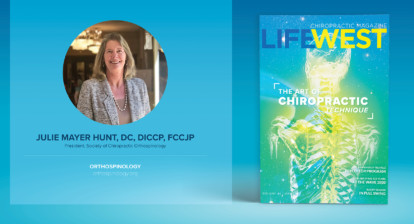This article on the upper cervical technique of NUCCA is based on an interview with Dr. Jeff Scholten. It is part of a collection of articles on different techniques in the Art of Chiropractic. Please find additional articles on the Art of Chiropractic on our website at lifewest.edu/magazine under the category “Vitalism” in the coming weeks.
Dr. Jeff Scholten
- President, National Upper Cervical Chiropractic Association
- nucca.org
Founded 1966
Dr. Scholten describes NUCCA technique as a set of procedures to correct subluxations in the upper neck. Imaging studies such as x-rays help find the misalignments and guide the adjustments with special studies (MRI, CT) while tests such as functional leg-length discrepancy, paraspinal thermometry, palpation, and postural tests help determine when an adjustment may be necessary.
The goal with NUCCA is not simply to move the joint, but to try to adjust joints back to a normal neutral position, Dr. Scholten said. The real essence of NUCCA is that the technique is focused on the relationship between the upper cervical spine and the spinomedullary zone of the central nervous system found at the base of the brain.
What’s happening now?
NUCCA chiropractors are very interested in continuing to enhance procedures for most efficiently evaluating and correcting vertebral subluxations, Dr. Scholten said.
When field chiropractors, or researchers, figure out an alteration to the procedures that they think is more efficient, there’s a process of introducing that development to the NUCCA standards board. If it passes peer-review scrutiny during this investigation, the new method becomes a NUCCA procedure. This enables the adoption of different procedures, which are based on the work of many people over time, Dr. Scholten said. With an ever-evolving set of procedures, the NUCCA procedures could be very different in a decade.
“We think this is a vital, complex area,” he said, describing the upper neck region where NUCCA techniques are focused, “and it deserves a dedicated practitioner. Some deal with this area successfully with less specificity, but we deal with high levels of specificity.” Using images to guide careful adjustments allows NUCCA practitioners to deal with quite complex situations.
What’s ahead?
As imaging studies improve, using less radiation or providing clearer images, that is sure to inform the NUCCA technique, Dr. Scholten said. He points to Cone Beam CT technology, which exposes a patient to far less radiation than even today’s modern low radiation X-rays and can still provide a lot of detail in a very focused area, much like a flashlight provides light on a very focused area.
“You can see tremendous detail regarding vertebral positioning and joint relationships when you are looking with cone beam machines, but with older CT technology you have to do more slicing of the area to get a reasonable perspective,” Dr. Scholten said, describing the tool. In the early 2000s, the technology progressed enough with more powerful computers that they could put together extensive information on hard tissue such as bones and teeth.
“In looking at the future, that’s something we’re really excited about,” Dr. Scholten said. “If we can do see more anatomy with less radiation, it’s full of so much possibility.”
NUCCA’s research arm is working with different companies that have specialized knowledge in this area, in a bid to make that technology more available and to help move things forward.
“For us, the NUCCA adjustment is an adjustment that is vector-based and therefore extremely precise, and never requires the neck to go to the end-range of motion,” Dr. Scholten said. “A NUCCA adjustment is done where the neck never leaves neutral. NUCCA is always trying to work toward providing the least amount of intervention possible to make the biggest impact in the relationship between the head and neck.”





